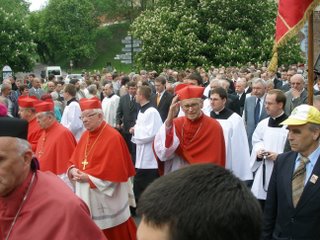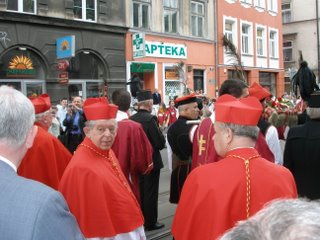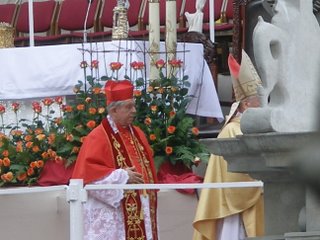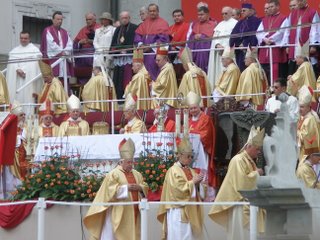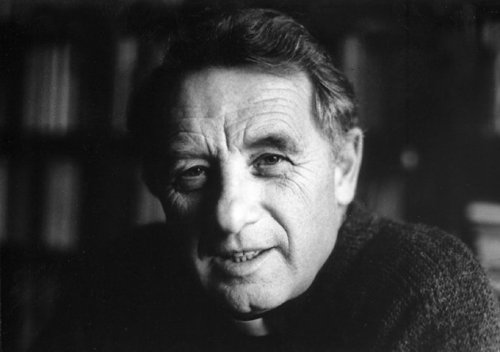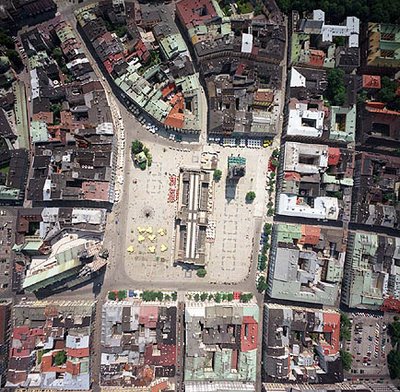Scott Hahn once wrote a widely read book, Rome Sweet Home. Well, I feel like I can say “home sweet home,” after coming back from Rome. This is obviously not to deny the fact that, as a Catholic, Rome is my spiritual “home,” but rather a sigh of relief that the crazy week of traveling and seeing the most amazing churches and museums that I have seen in my life has come to an end. Now, I will have some time to reflect upon and soak up all of the experiences of my Holy Week in Rome!
First of all, and most importantly, our trip was a pilgrimage, to spend the holiest week of the year with the Holy Father. And did we! I went with a group of guys from Poland to the UNIV conference, a conference that has been sponsored yearly since 1968, whose focus is to provide university students from around the world a chance to meet each other, and discuss important topics facing the Church. This year’s focus was on the “Role of the Mass Media in Shaping Catholic Culture,” and was very interesting. As part of the conference, the UNIV participants are traditionally granted a special audience with the Holy Father. Ok, so I won’t be falsely humble—I GOT TO TOUCH POPE BENEDICT! I only share this because it was an amazing experience. In fact, as it turned out, it was one of the three times that I would be within one or two feet of the Holy Father, but it was the only time that I was able to shake his hand. There was definitely an outward “radiation of sanctity” which emanated from Pope John Paul II, when I was able to be near him. This charismatic gift inspired many to go out and evangelize, to “not be afraid” to “open wide the doors to Christ,” and to preach the Gospel to the ends of the earth. This radiation of sanctity from John Paul was the Holy Spirit, the gift, who then led others to make gifts of themselves to the world. What struck me when I was near Pope Benedict was his simple humanity, and the silent, peaceful longing for interiority and contemplation. In a get-together with Bishop Javier Echevarria, the Prelate of Opus Dei, aware of the Pope Benedict’s character and personality, told us that he apologized to the Holy Father that so many people were trying to touch him, and that he understood if he felt overwhelmed. To this, Pope Benedict replied that he didn’t mind, because he know that the young people were reaching out, not to him, but to Christ, who is in their midst. How true—Christ is present in such a different way in this pope. One looks upon him, and having been sent on a mission by John Paul II, he is now reminded of the need for contemplation and prayer, which is the foundation of everything. It is only through prayer, and particularly in the Liturgy, that one can meet Christ in an ever-new way, and be refreshed to participate in the modern cultural dialogue the John Paul II called us to.
Of course, I refuse to play the game of “compare the popes,” and none of these reflections are meant to somehow say one pope is better than the other. They are simply personal reflections of the differences I have noticed in their personalities, and how their personalities both show us different aspects of the Christian life that must be emphasized.
What I never cease to be amazed by the mind of our Holy Father. Before the audience, we watched a video clip of his meeting with youth, on the Thursday before Pam Sunday. In this new tradition, the Holy Father met with youth and answered their personal questions about vocation, sexuality, and the crisis of culture. I was amazed by the Holy Father’s answers, which were not prepared before hand, but improvised on the spot. Or rather, they were the fruit of years of prayer and contemplation, as well as theological study. In his usual manner, he responded with flawless paragraphs of eloquent and deep prose, and left now question unanswered from a variety of different angles. We are so blessed to have a Holy Father who is a man of incredible prayer, deep reflection, and amazing intellect and wisdom!
In addition to the audience with the Holy Father, we were able to participate in all of the Papal Liturgies of the week—the Chrism Mass at St. Peter’s Basilica, the Mass for the Institution of the Eucharist on Thursday Evening in St. John Lateran, the Good Friday Liturgy at St. Peter’s, the Papal Stations of the Cross, as well as the Easter Vigil in St. Peter’s Basilica. (Oh yeah, and the Urbi et Orbi on Sunday on St. Peter’s Square). Though we didn’t have tickets to get into anything besides the audience, thanks to my awesome Notre Dame architecture friends who just happen to “have to” study in Rome for this year, we were able to get into everything, and have great seats, as well.
The week was definitely a crazy time of commuting to and from Via Aurelia, comparable only to the Las Vegas Strip, except with the amount of Catholic hostels, instead of casinos. On every block, there are at least a few houses or hostels run by one order or another. We were able to visit all four of the major basilicas, as well as a number of the famous churches in Rome. I’m sure that I will forget some, but right now I can remember the Gesu, Santa Maria Ara Coeli, San Agostino, San Luigi Re Fracese, San Stanislao Kostka, Santa Croce in Gerusalemne, Santa Trinita dei Monte, San Andrea della Valle, Santa Magdalena, Santa Maria Sopre Minerva, the Pantheon, and many others. These are most of the churches that we visited that house the relics of great saints, such as St. Ignatius in the Gesu, Saint Catherine of Siena and Blessed Fra Angelico in Santa Maria Sopre Minerva, Saint Josemaria Escriva in Santa Maria Della Pace, and the relics of the True Cross and the cross-beam of the cross of Dismas the Good Thief in Santa Croce. I forgot to also mention Santa Presetta, the 8th century basilica that houses the pillar upon which Christ was scourged. Obviously, a lot of people argue that these relics are a fraud and that they are not the actual ones.
First of all, even if they are not “the real thing,” they are places of veneration of the Passion of Christ that have been sanctified by the prayers of pilgrims throughout the centuries. There are man miracles associated with them, so whether they are the actual relics or not, they are still places of special grace. Secondly, it is very likely that these are the actual relics from Jerusalem, since Jerusalem was under Roman control in the late period of antiquity. Thus, if an emperor, such as Constantine, who was a Christian, was in control of Jerusalem, he could have easily brought the remnants of the relics associated with the passion of Christ to Rome. Hence the reason for the existence of the Scala Santa, as well as the other “artifacts” associated with the death of Jesus.
In addition to seeing many of these famous churches, I was also able to see many cultural and historical masterpieces, both works of art and architecture. Of course, we saw the Fontana di Trevi, which shocked me with its size. I never imagined the fountain to be so huge—the figures in it were at least twice life-size. In the Villa Burghese, a museum in the former family mansion of the famous Roman aristocrat Burghese family, we saw the most famous and well-known statues by Bernini, as well as paintings by Raphael, Caravaggio, and other masters of the Italian Renaissance. Bernini’s expression was absolutely amazing, particularly in his Apollo and Daphne, and in his David. Having never seen Bernini’s David, before, I was extremely impressed, and decided that I like it better than Michelangelo’s masterpiece. Whereas Michelangelo focuses on the idealism and sheer strength of man, by portraying David as a muscular and towering force, Bernini is more focused on the tension of the moment. He captures David in the split-second before he releases the sling with which he will slay Goliath. This produces an incredible tension and expression that is visible in the tense muscles of a young man, slender and realistically built. He is about to exert all of his strength in the one chance that he has to either save his people or be killed. The strength of the human spirit, of perseverance, will, and determination are all captured in this block of marble, which has been chiseled into perfection.
Of course, the Musei Vaticani also made a huge impression on me, where I was able to stand face-to-face with pieces of art, sculptures, and masterpieces that I have been reading about in textbooks since at least high school. I realized that it is one thing to read about a sculpture, or a painting, and another thing to stand in front of something that is 2500 years old (here, I am referring to the Lacöon Group). I was struck by the way that people more than two millennia ago were already able to express their spirit by creating masterpieces of art, which have lasted until today. Perhaps modern artists could learn something from these ancient and beautiful masterpieces, which have lasted for ages and are still admired for the beauty, because of their ability to capture and explore the fundamental truths of human nature!
It was quite frustrating to see all of the “tourists” in the Vatican Museums who had absolutely no clue about history or the tradition of the Church. Until one learns the medium, or at least about the medium, through which to view these works of art, it is as if he were only looking at the tip of the iceberg. It was sad to see all of the people who had no clue about what was painted in the frescoes, such as in the room with the Triumph of Christianity (I forget the name of the room). The most frustrating thing that I encountered there, and which I also often encounter here in Krakow, is when an English tour guide who is clearly not Catholic, and really has no clue about the tradition of the Church, seeks to explain to Americans or British about the art they are looking at, and has the job simply because he can speak English. Art is a dangerous thing, and one can either leave a place, having been brainwashed and misled to believing the half-truths which are so popular these days in pop culture, or he can truly seek to learn about what a painting really portrays, and the depth and importance of its meaning. Of course, which is easier?
In addition to seeing all of the beautiful churches and the works of both ancient and Early Modern Art, I was fascinated and greatly moved by my visit to the places of importance to the Early Christians, namely, the Via Appia Antica, and the Catacombs of St. Priscilla, in northern Rome. Entering into the catacombs, I was filled with images from the book Quo Vadis, by Henryk Sienkiewicz, probably one of Poland’s best-known modern authors, and winner of the Nobel Prize in Literature. In this novel, which I think every Christian should read, he provides a fascinating account of the life of the Christians during the reign of Nero. Though the story is fictional, the book and the situations described are historical, and essentially, he was the creator of the historical novel genre.
As we descended into down the spiral staircase from the sunny courtyard, I was filled with anticipation—I would be visiting the tombs and meeting places of those who preceded us in the Christian faith by 1700 years! In this huge complex of tunnels and various levels (more than 13 km of tunnels on all levels!), we stopped at the tombs of various wealthier Christians, as well as those of the poor, who were provide graves by the Christian community. The rich and ancient heritage of our faith was here before my eyes. We saw the oldest image of Mary in Christianity, holding the child Jesus, much like in the images of Our Lady that we see today. We also saw one of the oldest images of Christ, the Good Shepherd. Accompanying the images of Christ and of Mary, we saw many images of Susanna, from the Book of Daniel, who was a symbol of the early Church. Just as she was unjustly persecuted and accused of crime, so were the early Christians persecuted and accused of many false crimes. Often, there images of the three young men, Ananias, Azarias, and Misael, also from the Book of Daniel, who, though tried by fire by the pagan king, survived due to the protection of God, present in an angel in their midst. Likewise, the fires of the pagan Roman emperors tried the early Church, but the suffering Christ accompanied them in their trials.
One of the most interesting places in the catacombs was a large crypt, where the Christians would gather around the tombs of their relatives, and celebrate the Eucharist. Near it, there was a niche in the wall, with graffiti from US GI’s from the Second World War, who surely used the place as a hideout during the war. I was walking through history, but I was also touching the lives of thousands of people. Forty thousand people had once been buried in this cemetery, and thousands had come there before me, to be buried, to venerate the dead, or to seek shelter from dangers above.
In the same way, St. Peter once sought to leave the city of Rome, because of the persecution of the Christians. He believed that it would be safer for him to leave Rome and to guide his flock in safety, than to risk being killed and leave his flock abandoned. He decided to walk out of the city on the Via Appia, a seek shelter among the Christian outside the city. Here, in the midst of the green Mediterranean fields and the hot Roman sun, a bright light appeared, and Jesus stood before him—walking toward the city. “Domine, Quo Vadis?” (Lord, where are you going?), asked the shocked and dumbfounded Peter. “I am going to be with my flock,” replied Jesus, walking towards Rome. At this moment, Peter realized that he was not called to abandon his people, but that he was called to return to Rome, to suffer with them, and to die with them, should it come to this. To this day, the spot on which Jesus appeared is commemorated by the Capella Domine Quo Vadis on the Via Appia, near the catacombs of St. Sebastian. Inside, there is a rock in which are imprinted the footprints of Christ, to which faithful have come throughout the millennia, to venerate the spot which led Peter to his martyrdom for the glory of the cross.
I’ve been to this spot. It is true. This is the beauty of the antiquity of our faith. “The Church is alive,” Pope Benedict reminds us, and her liveliness comes from the centuries of Christians who have come before us, to witness to the faith and truth of Jesus Christ, and who have not been afraid to suffer and die for Him.





